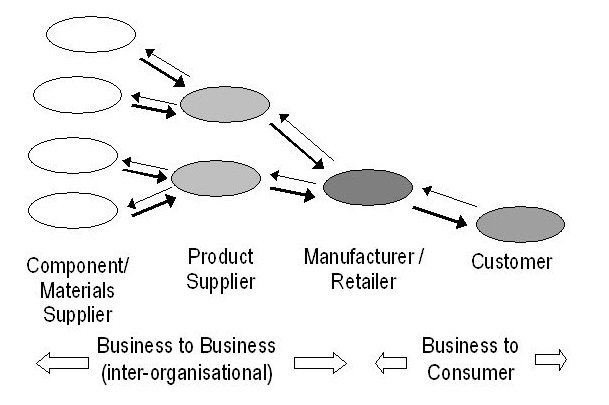Inter-organizational Transaction e-commerce refers to the full spectrum of e-commerce that can occur between two organizations. It is the e-commerce between businesses i.e. the businesses focus on selling to other businesses in the B2B e-commerce.
Companies are now mutually buying and selling products and services on the internet. The term was coined and first employed by Dr. Robert Jacobson, Principal Consultant to the California State Assembly’s Utilities & Commerce Committee, in the title and text of California’s Electronic Commerce Act, carried by the late Committee Chairwoman Gwen Moore (D-L.A.) and enacted in 1984.
Inter-organizational e-commerce may reduce transaction costs, increase the availability of products and suppliers and reduce dependencies on a few trading partners and products.
Moreover, they offer many secondary services for integrating purchasing, distribution, and inventory processes, streamlining the entire transaction process. Thus, it allows for better inventory management, quality control, and supply chain processes.
Business organizations are constantly buying and selling goods and services. Shops buy products in bulk from their suppliers and sell those goods in small quantities to their customers.
Inter-organizational e-commerce refers to the full spectrum of e-commerce that can occur between two organizations. It is the e-commerce between businesses i.e. the businesses focus on selling to other businesses in the B2B e-commerce.
It includes companies doing business with one another with the goal to save money on purchases that can be negotiated easily. Companies are now mutually buying and selling products and services on the internet.
Inter-organizational e-commerce may reduce transaction costs, increase the availability of products and suppliers and reduce dependencies on a few trading partners and products.
Moreover, they offer many secondary services for integrating purchasing, distribution, and inventory processes, streamlining the entire transaction process. Thus, it allows better inventory management, quality control and supply chain processes.
Business organizations are constantly buying and selling goods and services. Shops buy products in bulk from their suppliers and sell those goods in small quantities to their customers.
Manufactures buy raw material or components from their suppliers, assemble them into new products and sell them to their customers. Retailers make a great number of transactions and the whole operation of their business is dependent on their effective execution.
Other business service sector organizations such as accountants may be less dependent on a constant flow of goods but they still need supplies and they are careful to account for the transactions with their transactions.
Retailers make a great number of transactions and the whole operation of their business is dependent on their effective execution.
Other business service sector organizations such as accountants may be less dependent on a constant flow of goods but they still need supplies and they are careful to account for the transactions with their transactions.
There are five essential categories of E-commerce:
- Business to Business
- Business to Consumer
- Business to Government
- Consumer to Business
- Consumer to Consumer
For all businesses, there is a web of inter-organizational transactions. This web of transactions forms a value chain and is illustrated as the Logistics Network in the following figure:
